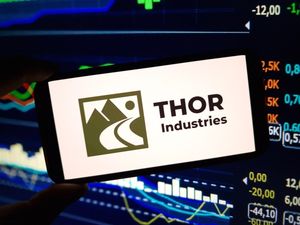
September 25, 2025 – Tesla (NASDAQ: TSLA) shares experienced a notable decline today, trading lower amid broader market weakness and specific concerns stemming from a significant slump in its European sales performance. This downturn, which saw TSLA shares drop by over 3% to 4% throughout the day, trading around $424.54 to $429.07, marks a cautious shift in investor sentiment, even after a period of strong gains for the electric vehicle (EV) giant. The immediate implications point to a heightened competitive environment and a re-evaluation of Tesla's market dominance, particularly in a maturing European EV market.
The market's reaction today underscores growing concerns about Tesla's ability to maintain its aggressive growth trajectory in the face of formidable challenges. While the stock has enjoyed a remarkable rally in recent weeks, gaining approximately 28% this month, the recent European sales figures are casting a long shadow, prompting investors to scrutinize the company's immediate operational health and long-term strategic positioning.
A Deep Dive into Tesla's European Struggles
The primary catalyst for today's stock movement was the release of August 2025 new car registration data by the European Automobile Manufacturers' Association (ACEA). The figures painted a challenging picture for Tesla in the European Union (EU), revealing a steep decline in sales and a significant erosion of market share.
Tesla's new car registrations in the EU plummeted by 36.6% in August 2025 compared to August 2024, reducing its market share from 2% to 1.2%. Year-to-date (January-August 2025) figures were even more stark, showing a 43% fall in new Tesla cars sold across the EU. This significant decline occurred while the overall European electric vehicle market experienced robust growth, with battery-electric vehicle sales collectively rising by 30% in August 2025. This divergence strongly suggests that Tesla's struggles are company-specific rather than indicative of a broader EV market contraction.
Adding to Tesla's woes is the aggressive expansion of Chinese rival BYD (BYDDF). For the second consecutive month, BYD outsold Tesla in the European Union in August 2025. BYD's EU sales surged by an impressive 201.3% year-over-year in August, securing a 1.3% market share and thereby surpassing Tesla's 1.2%. This Chinese automaker's success is attributed to its competitive pricing and a diverse product portfolio, including plug-in hybrids (PHEVs), which cater to a wider market and can circumvent some EU tariffs. The timeline leading up to this moment shows a consistent pattern of decline for Tesla in Europe, with August marking the eighth consecutive month of declining sales for the company in the region.
Key players involved in this unfolding narrative include Tesla itself, with CEO Elon Musk's public statements and strategic decisions often influencing market sentiment. BYD and other Chinese automakers are formidable competitors, while established European manufacturers like Volkswagen Group (XTRA: VOW), BMW Group (XTRA: BMW), and Stellantis (NYSE: STLA) are also intensifying their EV efforts. The European Automobile Manufacturers' Association (ACEA) serves as a crucial data provider, and regulatory bodies like the European Commission play a role in shaping the competitive landscape through policies such as tariffs on Chinese EVs.
Winners and Losers in the Shifting EV Landscape
Tesla's European sales slump is creating a ripple effect across the automotive and EV battery industries, producing clear winners and losers.
Winners: The most significant beneficiary is BYD (BYDDF), which has not only surpassed Tesla in European EV sales but also continues its explosive growth, driven by competitive pricing and a diverse product portfolio that includes popular plug-in hybrids. European legacy automakers are also gaining ground. Volkswagen Group (XTRA: VOW), the leading OEM in the European EV market, saw its EV sales increase by 45% in August 2025, leveraging its diverse "ID." series. BMW Group (XTRA: BMW) maintained a strong presence with a 7% increase in EV sales, while Stellantis (NYSE: STLA) and Renault (XTRA: RNO) also posted positive sales growth. Other Chinese brands like NIO (NYSE: NIO), XPeng (NYSE: XPEV), and SAIC Motor (SS: 600104) are aggressively expanding, posing a significant challenge to Tesla's market share with tech-rich and competitively priced EVs.
Losers: The most apparent loser is Tesla (NASDAQ: TSLA) itself. Its stock has seen significant declines linked to the European sales figures, and the company is experiencing a tangible loss of market share, increased financial pressure, and a damaged brand reputation, necessitating a strategic re-evaluation of its European approach. Analysts are lowering full-year sales forecasts and predicting risks to deliveries and earnings expectations.
The impact on EV battery suppliers is more nuanced. While suppliers heavily reliant on Tesla for European contracts, such as CATL (SZ: 300750) (which supplied a significant portion of batteries for Tesla's Model 3 in Europe), might experience a dip in orders, diversified suppliers or those primarily supplying Tesla's growing competitors stand to gain. For instance, LG Energy Solution (KRX: 373220), a leading European supplier, and Samsung SDI (KRX: 006400) (supplying BMW) are well-positioned as European automakers increase their EV output. The push for localized supply chains also benefits European battery manufacturers like Northvolt.
Wider Significance: A Maturing Market and Policy Interplay
Tesla's European challenges are symptomatic of a maturing and increasingly competitive EV market, marking a pivotal moment for the global automotive industry. This event underscores that the early-mover advantage is no longer sufficient to guarantee market leadership.
The broader EV industry trend reveals a shift from Tesla's near-monopoly to a highly fragmented and competitive landscape. Consumers in Europe are increasingly prioritizing value, diverse product lineups, and localized offerings, moving beyond the "one-size-fits-all" approach. Furthermore, the perceived aging of Tesla's model lineup, with no major mass-market updates since the Model Y in 2020, stands in contrast to the continuous influx of fresh, competitively priced models from rivals. CEO Elon Musk's polarizing public persona and political affiliations have also reportedly alienated a significant portion of European consumers, directly impacting sales in culturally sensitive markets.
Ripple effects are evident across the industry. Chinese automakers are not just competing on price but are also investing in local manufacturing, as seen with BYD's plans for facilities in Hungary, to strengthen their foothold and potentially mitigate future tariffs. European legacy automakers are reclaiming market share by leveraging localized production and offering models tailored to regional preferences, often benefiting from government incentives for domestically produced vehicles.
Regulatory and policy implications are significant. The abrupt end of state subsidies for EVs in countries like Germany and targeted incentives in France favoring locally manufactured vehicles have directly impacted Tesla's competitiveness. The European Union's anti-subsidy tariffs on Chinese EVs, while affecting Tesla's Shanghai-produced vehicles, have also prompted Chinese manufacturers to diversify their offerings (e.g., into hybrids) and consider local production to navigate these trade barriers. Tesla has challenged these tariffs, arguing they hurt competition and innovation.
Historically, the automotive industry has seen similar shifts. The experience of the Ford Model T in the 1920s, initially revolutionary but eventually challenged by consumer demand for variety, offers a parallel. Similarly, the "Lopez era" at Volkswagen in the mid-1990s highlighted the impact of aggressive price competition. Tesla's current situation reflects a similar dynamic, where market saturation and intense competition are forcing adaptation from previously dominant players.
What Comes Next: Adapt or Be Overtaken
The road ahead for Tesla and the European EV market is one of intense competition and strategic adaptation.
For Tesla, in the short-term (2025-2026): The immediate priority is to reverse the sales decline. This will likely involve accelerating the launch of a more affordable compact model (informally referred to as "Model Q" or "Model 2"), potentially priced around $25,000, as early as Q4 2025. Efforts to cut production costs for next-generation vehicles by 50% through innovative manufacturing techniques and new battery technologies are crucial. While heavy investments in AI and robotics (e.g., deploying 10,000 Optimus humanoid robots by 2025) could limit short-term profitability, they are foundational for Tesla's long-term vision.
Long-term (2027 and beyond): Tesla aims for aggressive international expansion and increasing production capacity to reach 20 million vehicles annually by 2030. A significant pivot is its transformation from primarily a carmaker to a tech-driven mobility and robotics platform, with substantial bets on robotaxis and humanoid robots. Continued advancements in battery technology and positioning itself as a "software-first" company, driving recurring revenue through subscription-based models, are also key.
Strategic Pivots Required: Tesla needs to rebuild its brand, distancing it from controversy and re-emphasizing innovation and sustainability. A refresh of its product lineup with more diverse and affordable models, particularly for the European market, is essential. Adaptive pricing strategies, scaling European production at Gigafactory Berlin, and enhancing its charging infrastructure and service networks will also be critical.
Market Opportunities and Challenges: The overall European EV market is expected to grow, creating opportunities for all players, especially for affordable EVs. Advancements in battery technology and expanding charging infrastructure will further accelerate adoption. However, hyper-competition, persistent price pressure leading to margin compression, and potential supply chain constraints (e.g., battery supply) remain significant challenges. Regulatory uncertainty and varying economic conditions across Europe also present headwinds.
Potential Scenarios: The European EV industry could see continued growth with diversified market leadership, where Tesla maintains a strong presence but shares dominance with European and Chinese manufacturers. Alternatively, an intensified price war could lead to consolidation, benefiting companies with superior cost efficiencies. Infrastructural and regulatory bottlenecks could also slow adoption in some regions. Finally, competitors could achieve technological leapfrogs, challenging Tesla's perceived innovation edge and forcing it to rapidly commercialize its own advanced projects to maintain relevance.
Comprehensive Wrap-Up: A New Era for EVs
Tesla's European sales slump and corresponding stock movement on September 25, 2025, are more than just a momentary blip; they signify a profound shift in the global electric vehicle market. The key takeaway is clear: the era of unchallenged dominance for any single EV manufacturer is likely over. The market is maturing into a highly competitive and fragmented landscape where innovation, affordability, regional relevance, and robust brand management are paramount.
Moving forward, the European EV market will remain a hotbed of activity and growth, but leadership will be increasingly diversified. Chinese automakers like BYD are proving to be formidable contenders, while traditional European giants are rapidly catching up and leveraging their localized strengths. This intense competition will ultimately benefit consumers through more diverse offerings and competitive pricing.
The lasting impact of this period will be a more dynamic and resilient EV ecosystem. It will force all players, including Tesla, to be more agile, innovative, and responsive to evolving consumer demands and geopolitical landscapes. The influence of a CEO's public image on brand loyalty, especially in global markets, has also been starkly highlighted.
For investors, the coming months will be critical. Watch closely for concrete announcements from Tesla (NASDAQ: TSLA) regarding new, more affordable models specifically for Europe, significant refreshes of its existing lineup, and any strategic pivots in its European production and service networks. Pay attention to the continued sales growth and market share gains of Chinese EV manufacturers like BYD (BYDDF) and the performance of traditional European automakers like Volkswagen Group (XTRA: VOW). Scrutinize Tesla's financial margins, as increased competition could lead to further price adjustments and margin pressure. Finally, stay informed about any changes to EU tariffs on Chinese EVs and evolving incentive programs, as these policies will continue to shape the competitive landscape for all EV players.
This content is intended for informational purposes only and is not financial advice.





